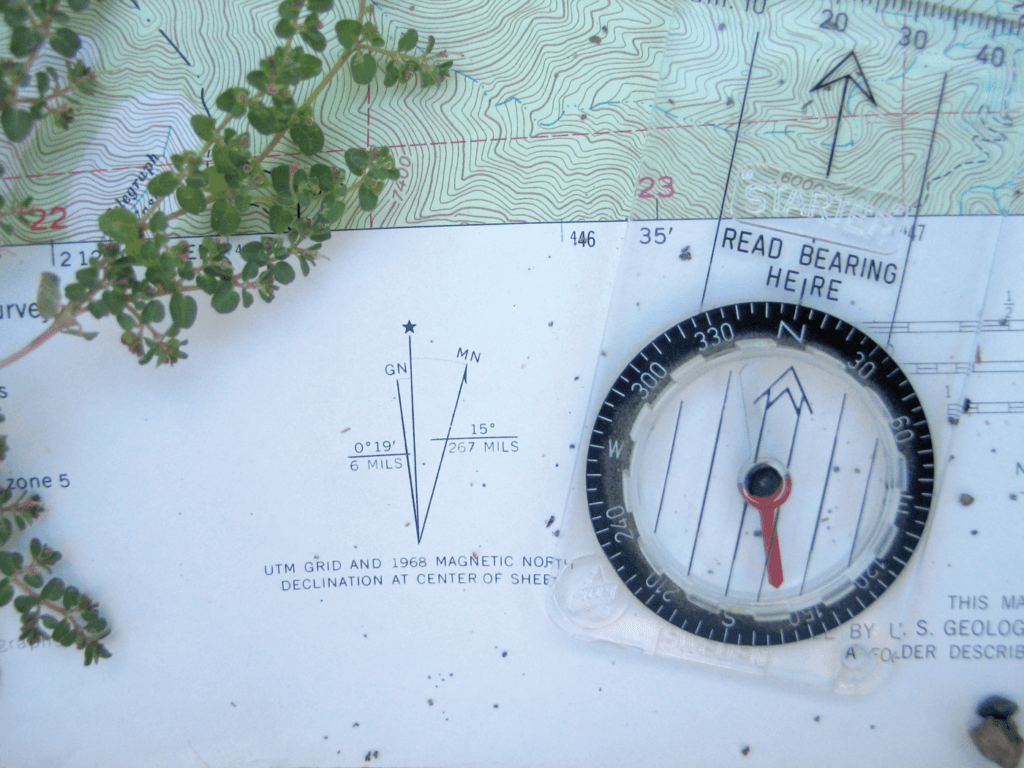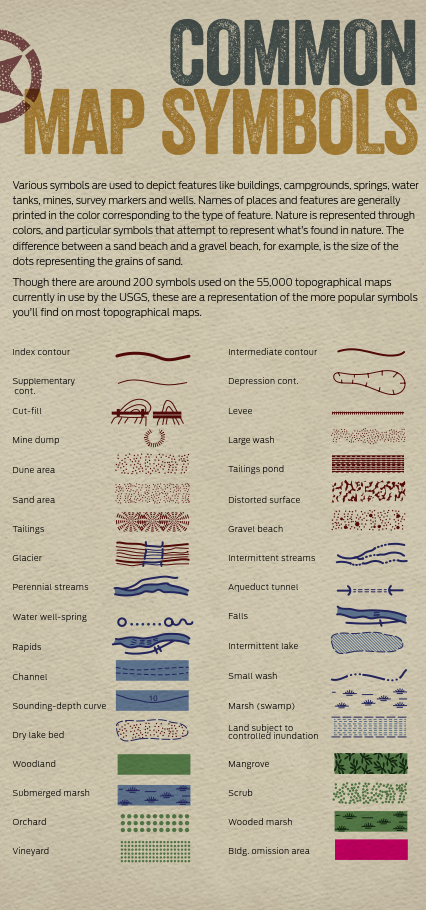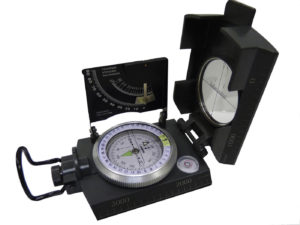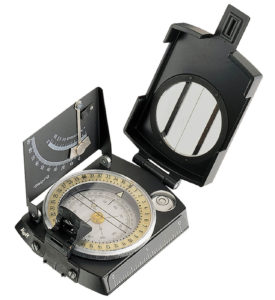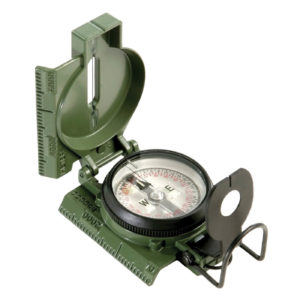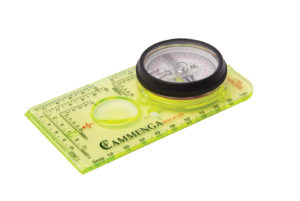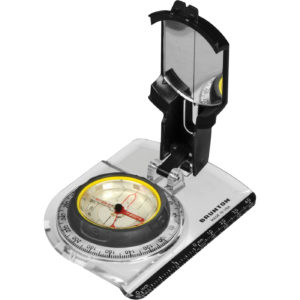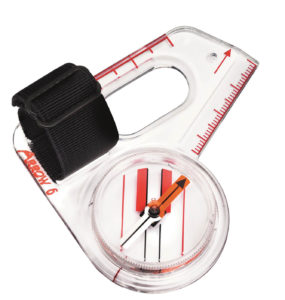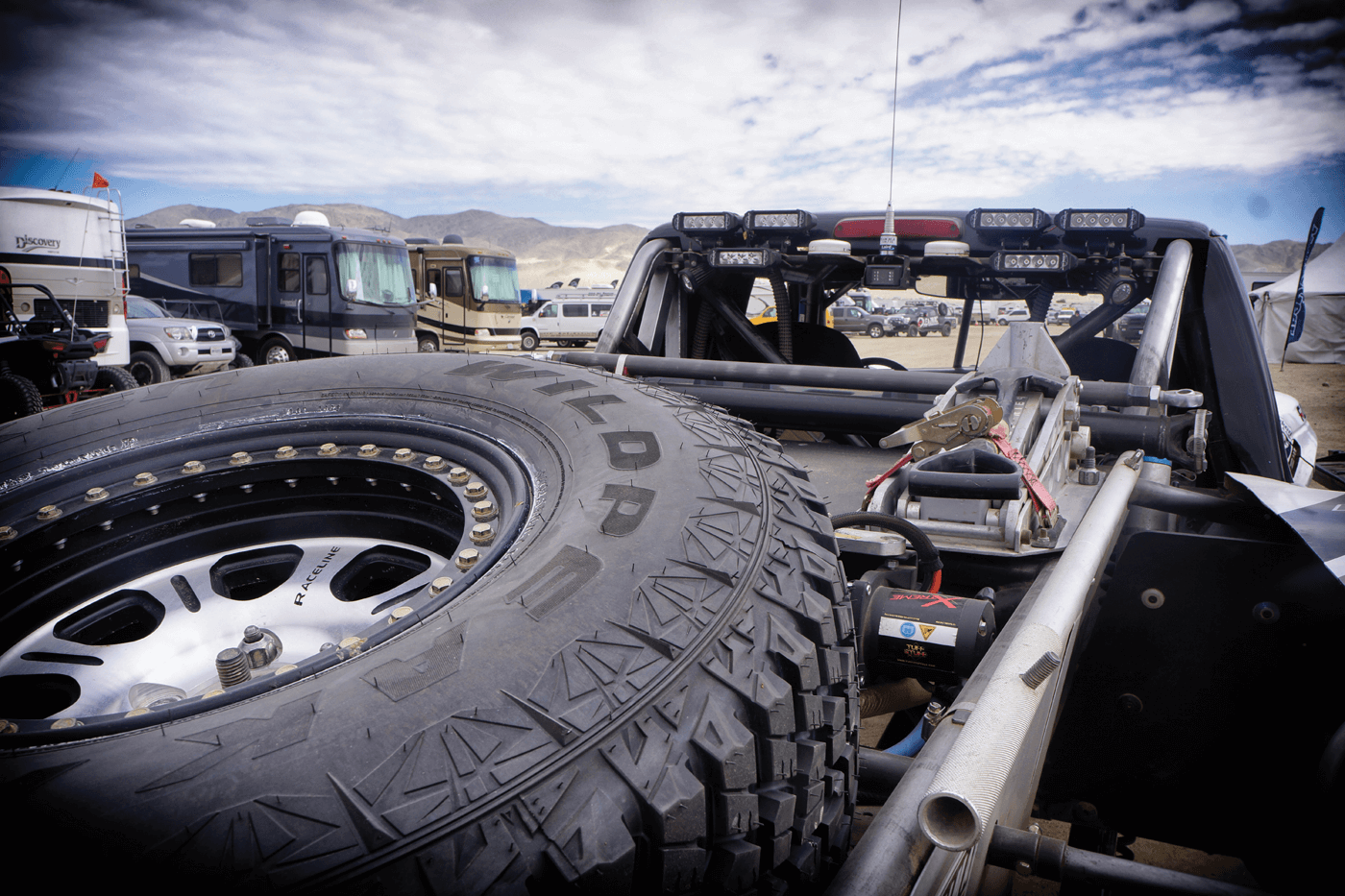Map-and-Compass Skills: How-To
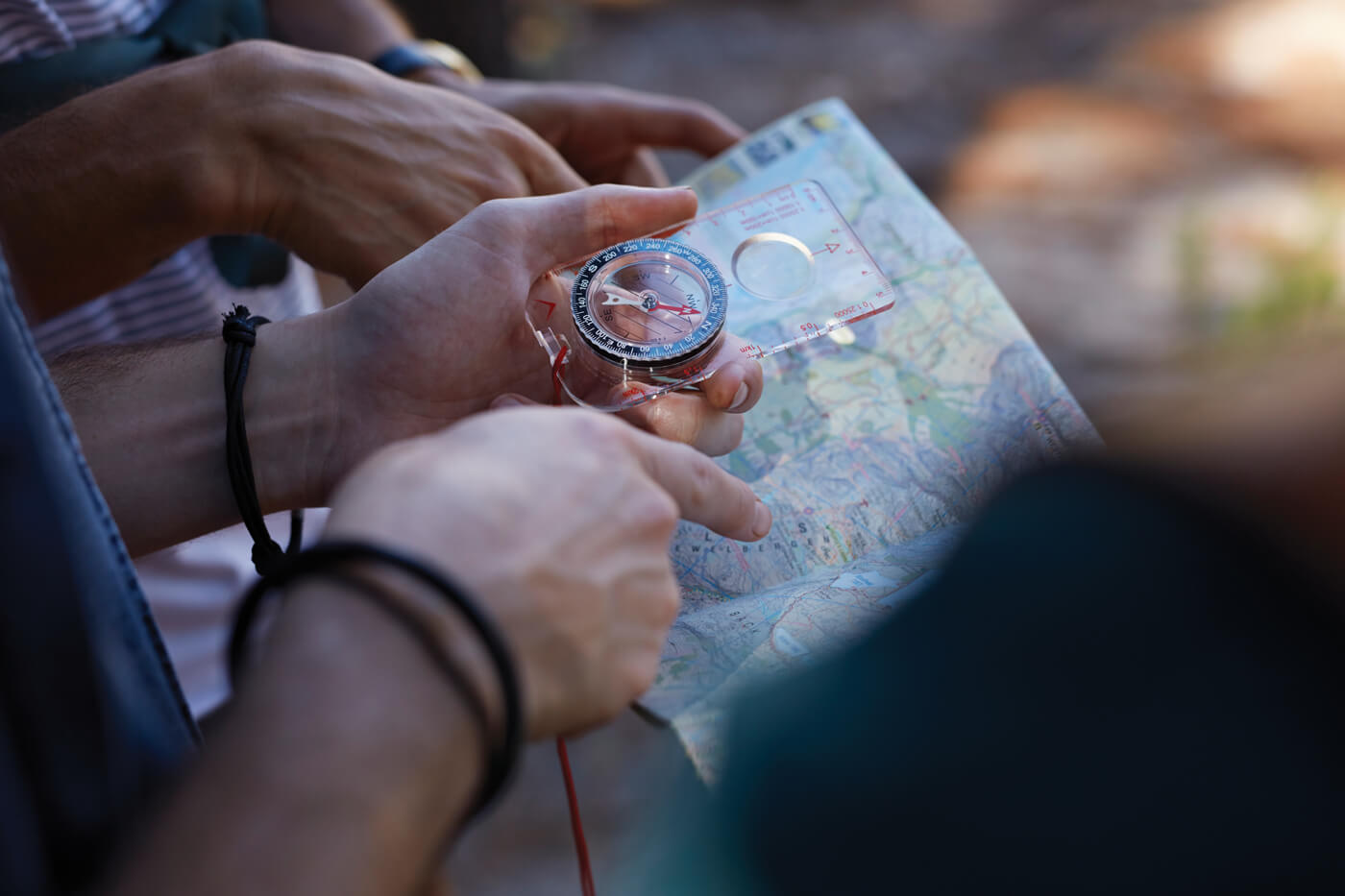
Find your way, old school, with map-and-compass skills.
Nobody ever loses their way, it seems, and nobody needs to ask for directions, either. In our pockets and on our dashboards are navigation devices so advanced, they can pinpoint your location down to a few inches— thanks to satellites orbiting hundreds of miles above your head. The problem with this is that people do get lost. Batteries run dry. Phones die. Signals get dropped. Navigation systems fail. You get lost. Your reliance on technology when you are wheeling in unfamiliar terrain, hundreds of miles from home, could very well be your downfall. In your cache of gear you should always have map-and-compass skills on deck. Plus, you’ll need some gear, including a topographical map covering your current area and a compass. Not just that, but you should have the knowledge of how to use them to find your location, and the skills to navigate to your final destination.
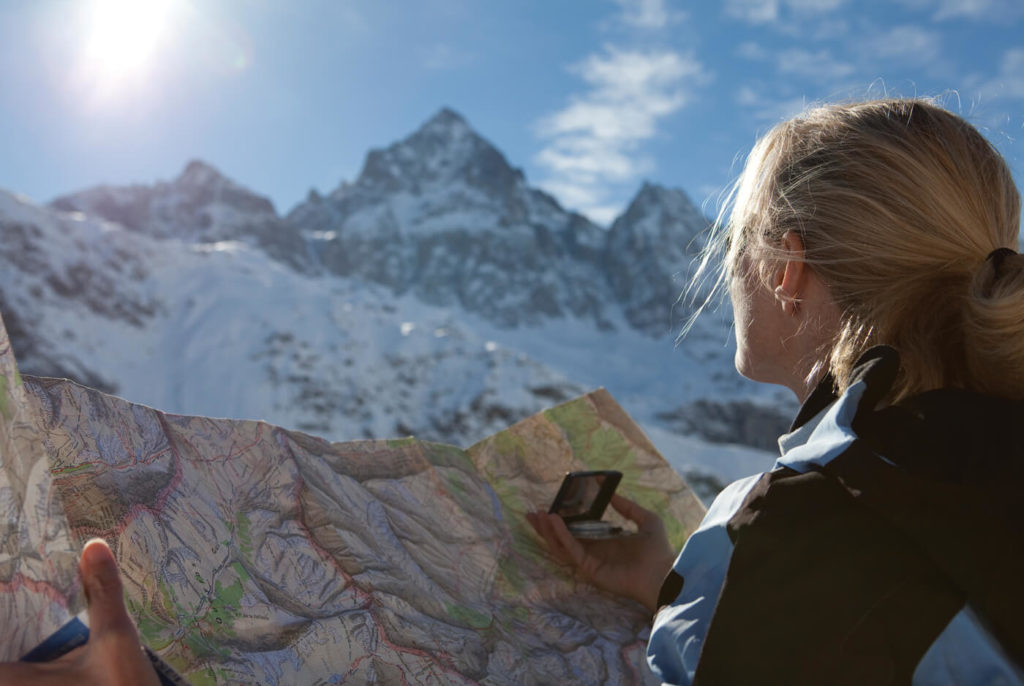
Reading and orienting a map is a very important skill to master, for anyone who plans to spend any amount of time in the backcountry. By coordinating a compass with a map, you’ll be able to match the features of the map with features in the real world, allowing you the ability to navigate toward any destination on the map.
Wars Make Maps
Early explorers of this continent charted the coastline soon after arriving, but the government’s recognition of the need to create maps didn’t come until 1777, during America’s Revolutionary War. Over the next 100 years, wars and skirmishes spurred advancements in map making, surveying and exploring. It wasn’t until 1884 that John Wesley Powell, the second director of the U.S. Geological Survey (USGS), began a systematic topographic mapping of the United States.
The original scale was 15-minute, meaning an area covering 1/16th of one degree of longitude/latitude, with a scale of 1:62,500. In the 1940s, demand for more detail resulted in 1:24,000-scale, 7.5-minute maps. Called a quadrangle, the map contains 7.5 minutes of latitude and longitude (1/32nd of one degree).
On these new maps, one inch equals 24,000 inches of real-world land. It wasn’t until 1991 that the USGS completed mapping the entire lower 48 states, using this new scale. The coverage includes more than 55,000, 7.5-minute quadrangles.
Map Colors
With the larger scale, the USGS included almost 200 different features separated into five color groups:
Cultural features, smaller roads, buildings and man-made things, such as trails, are printed in black.
Main roads and political boundaries are in magenta/red; woodland areas and other vegetation are green.
Rivers, lakes, glaciers and water features, are blue.
Contour lines, depressions, and mountain features, are printed brown.
(If you see purple, that means it is an update from a previous version, though it’s a color the USGS doesn’t use anymore.)
The various colors make reading a map easy, but there’s one more component required to read a topographical map: real-world terrain. Once mastered, by merely looking at a topo map, you’ll visualize the terrain as if you were standing before it. It is an incredible asset to your map-and-compass skills, but it takes time and experience.
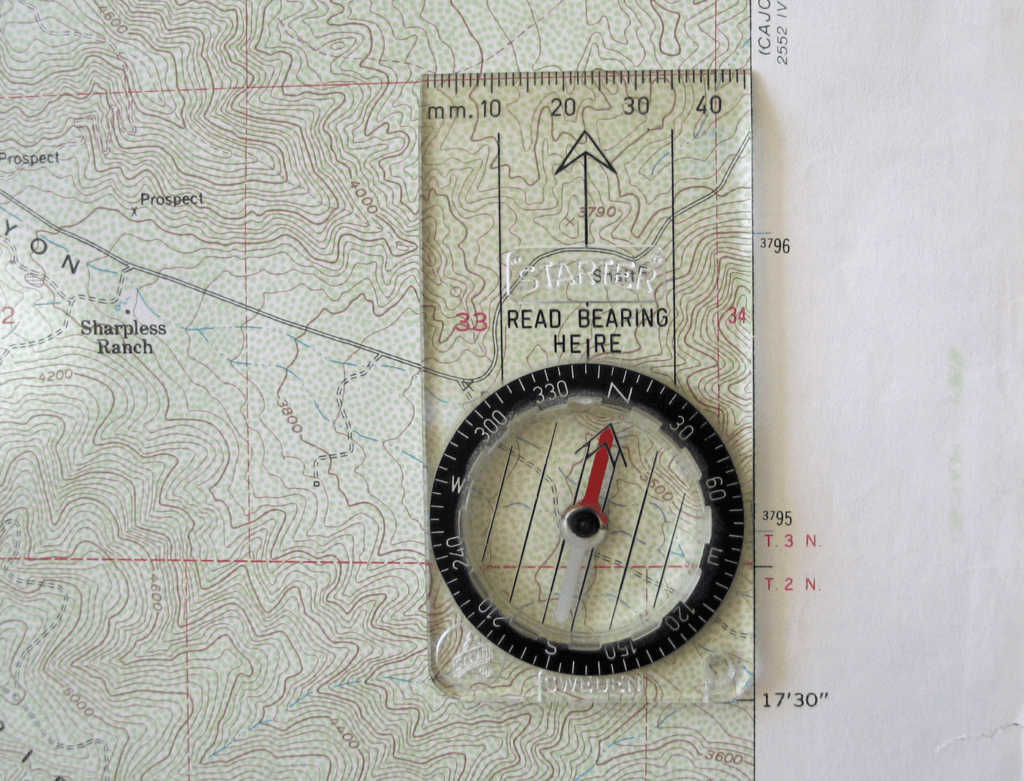
Holding the map and compass steadily together (the compass should be on the north-to-south map “neat line”), rotate the map and compass at the same time, until the red magnetic needle lines up with the orienting arrow on the compass face. Your map and your compass are now oriented to true north. Look around and compare the physical features around you with your map; they should be an exact match.
Contour Lines
Contour lines are imaginary; they represent segments of the ground that share an equal elevation, as well as defining the shape of the terrain’s features. They tend to parallel each other, each approximately the shape of the ones above and below it. If you’re working on your map-and-compass skills, here’s one thing to keep in mind: not all contour lines are created equal.
Heavier contour lines are known as indexed contour lines, and normally show elevation in feet. Typically, every fifth contour line is an index contour line. Lighter contour lines, which fall between indexed lines, are known as intermediate contour lines. These lines do not have their elevation listed, and are found in sets of four between indexed contour lines.
At the bottom of the map, under the scale, the contour interval will be listed. Normally it is 40 feet, meaning there is 40 real-world feet between contour lines, and 200 feet between indexed contour lines.
The closer the spacing of the contour lines, the more rapid the elevation change of the feature. This is important when using your map-and-compass skills to traverse an unknown region, as a steep hill or deep gorge would have contour lines close together, while widely spaced contours indicate a gentle slope.
Getting Oriented
It is common practice that all maps are oriented with true north at the top. At the bottom of the map will be a symbol of arrows pointing to the geographic North Pole (shown by a star), magnetic north (MN) and grid north (GN). When it is made, a map is generally oriented to correspond to the ground it represents by rotating the map so that north on the map is aligned with true north in the real world. Orienting a map is critical because it allows you to point in a direction and know, with confidence, what terrain lies ahead. Orienting a map is commonly done via one of two ways: by terrain association or with a compass.
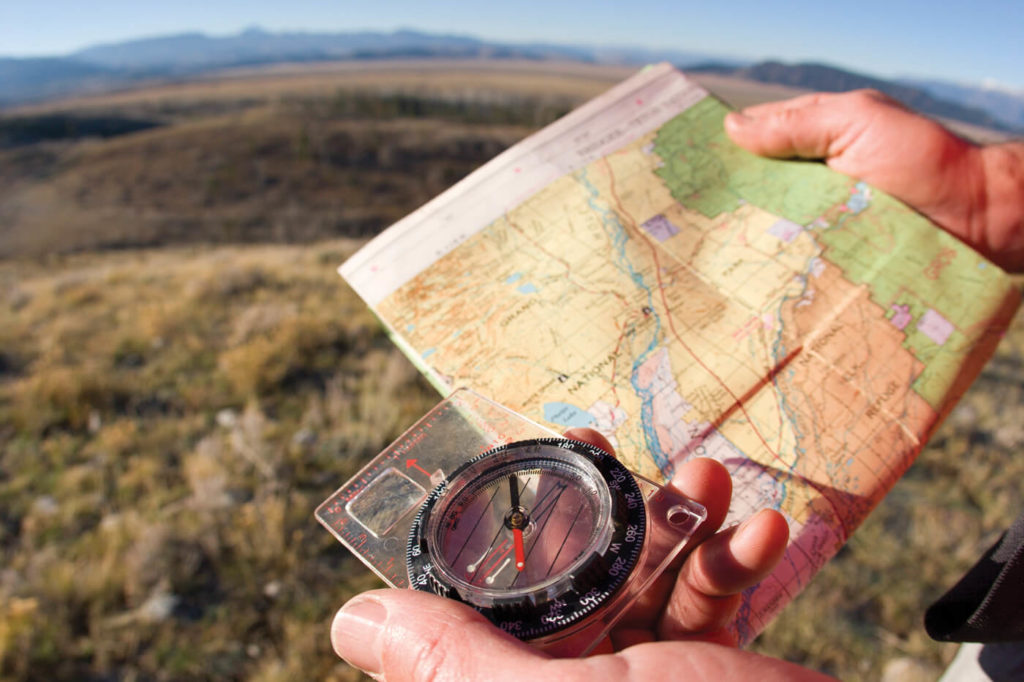
To orient your map, place the compass on the map so it is parallel to the north-to-south border of the map, known as the “neat line.”
Terrain Association
What if your compass breaks? Let’s say, you take a spill down a hill and it smashes on a rock, or you lose it. What then? How will you know where you are going or which way you need to go? You’ll have to orient your map based on what you can see, and this is easier to do if the area you are in has definite features, like a tall mountain or a deep ravine. If you are in an area with few to no reference points, like on the plains or in the rainforest with view obstructions, it will be considerably more difficult—but not impossible.
Hold the map in front of you and look around. Are there mountains? A cliff? A river? Can you find it on the map? If so, which direction is it in? Turn the map so it faces in that direction; and then, look for something else to cross-reference, or find a defining feature on the first object to further your orientation. It’s not an exact science, but at least it will help you head in the right direction.
Using a Compass
A compass will always point north. The problem is that the compass doesn’t point directly to the North Pole. Instead, it always points to the magnetic north pole, which is currently somewhere in northeastern Canada. A map, however, points directly toward true north, and good map-and-compass navigators have the skills to know the difference in the real world.
Magnetic declination is the number of degrees and direction between true north and magnetic north. Because declination varies over time, it is advisable to get a reasonably current figure by using a current map. If magnetic north is east of true north, the local declination is positive. If magnetic north is west of true north, the local declination is negative.
Pointing North: 6 Must-Have Compasses
Mountain passes and arroyos clogged with twisted foliage and broken trails can be confusing when you’ve lost your way. The sun might peek into a canyon for only a brief moment before disappearing behind the rim again. Subtle turns of the trail mask your direction. This confusion can induce a panic that will sap your energy, your ability to reason, and to make smart decisions.
You’ve got some map-and-compass navigation skills, but which compass do you have on hand?
KONUS KONUSTAR
This is part of Konus’s full line of professional compasses. They have a full-metal body, and indispensable features like a clinometer, a level bubble, a tripod attachment and a 360-degree eyepiece.
FEATURES
Full-metal body, liquid filled, clinometer, level bubble, two scales, tripod attachment, 360-degree eyepiece
MSRP: $45
K&R MERIDIAN PRO
The Meridian Pro features both a flip-up sighting prism and a rotating bezel, giving this compass two uses: a traditional hand-held compass, or an optical sighting transit. It weights nearly eight ounces.
FEATURES
Durable aluminum body, fluid-filled dampening, integrated clinometer bubble level, inch and mm scales, flip-up sighting prism, luminescent bezel and north points, metal bezel with 0-360 azimuth scale (five-degree resolution)
MSRP: $160
CAMMENGA TRITIUM 3H
cammenga.com
As the U.S. Military’s official compass manufacturer, Cammenga’s Tritium Lensatic compasses are famous for their durability and accuracy. Each compass has a self-powered lighting system that needs no recharging.
FEATURES
Equipped with seven Tritium micro-lights, providing continuous illumination for over 12 years; shockproof; damage-resistant design; waterproof to considerable depths; sandproof for extra durability.
MSRP: $102
CAMMENGA DESTINATE TRITIUM PROTRACTOR D3-T
Equipped with six Tritium micro-lights, this compass provides continuous illumination for over 12 years. So even in total darkness, you’ll be ready. Take and transfer bearings, calculate declinations and triangulate with the ultimate confidence. The Destinate Tritium Protractor Compass’ accuracy provides the efficiency and speed needed to navigate any terrain.
FEATURES
Map-magnifying glass; four map scales, for easy navigation on a variety of maps; dial graduations, in both degrees and mils; functional in temperatures ranging from -50 to 150 degrees Fahrenheit.
MSRP: $70
BRUNTON TRUARC 7
brunton.com
TruArc 7 mirrored compasses feature an inclinometer for measuring apparent tree heights and gauging avalanche danger, and can be a sighting tool for even more accurate headings. The TruArc Global Needle system and tool-less declination compensation ensure worldwide compatibility.
FEATURES
Global Needle, two-degree resolution, sighting mirror, clinometer
MSRP: $35
SUUNTO ARROW-6 THUMB COMPASS
suunto.com
A very simple compass, with very few amenities, the liquid-filled Arrow-6 comes equipped with a jeweled-bearing needle that settles quickly. It’s ideal for those with sharp map-and-compass skills, who do not need a compass cluttered with details that only get in the way of working with the map.
FEATURES
Thumb compass, high-speed needle for competitive orienteering, balanced for the northern hemisphere,
rotating capsule, lightweight at 0.95 ounces, metric scale, waterproof
MSRP: $56
THE DETAILS:
Breaking Down the Features of a Topographical Map
Here are some examples for you as you’re sharpening your map-and-compass skills:
The examples below are from the Waterman Mountain and Fontana quadrangles in Southern California—about 10 miles north of Pasadena in the Angeles National Forest, and about 40 miles east of Los Angeles in the San Bernardino Mountains, respectively. The mountains north of Los Angeles offer a wide range of topography that well illustrates the various elements of a typical topographical map.
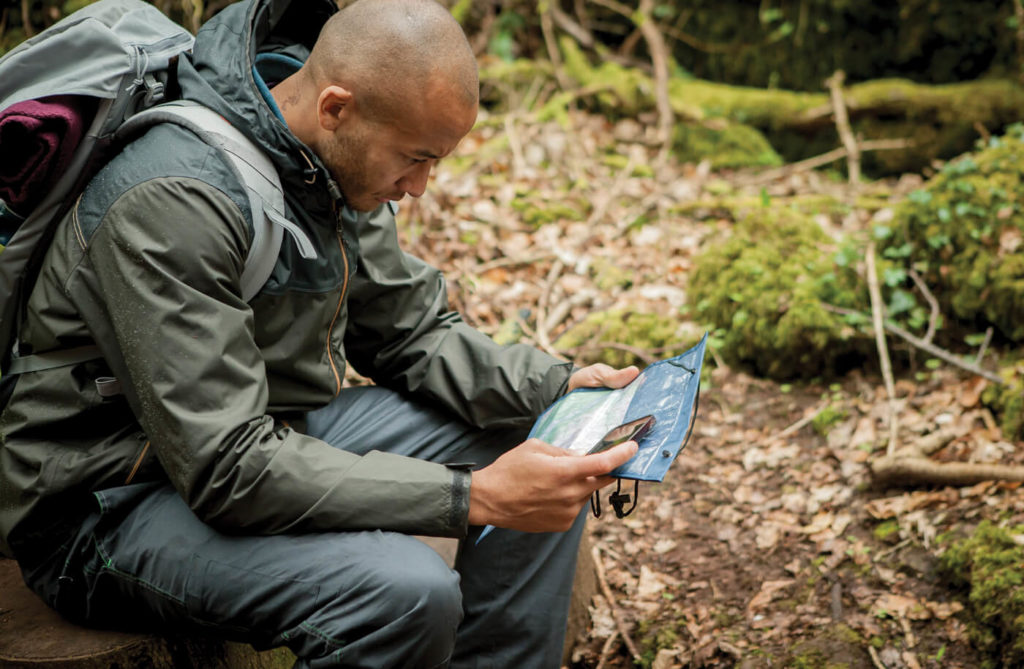
Rotate the compass dial until north on the compass ring lines up with north on the map. Find the magnetic declination on your map. In this case, it 15 degrees positive (east). If the local declination is positive, subtract the declination amount from the bearing you just derived. If the local declination is negative, add the declination amount to the bearing you just derived.
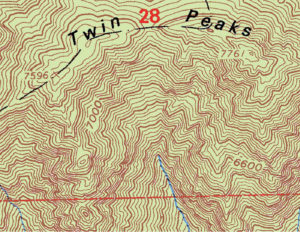 01 Just south of Twin Peaks is a rather narrow canyon, where the west fork of the Bear Creek originates. The contour lines here are close together, signifying steep terrain on both sides of the stream. Map-and compass navigators can use their skills (and the 6,600 elevation noted to the right) to determine how deep the canyon is, compared to the highest peak (7,761). Every index contour line represents a difference of 200 feet, so the stream is roughly 1,761 feet below the east Twin Peak. This would not be an easy climb.
01 Just south of Twin Peaks is a rather narrow canyon, where the west fork of the Bear Creek originates. The contour lines here are close together, signifying steep terrain on both sides of the stream. Map-and compass navigators can use their skills (and the 6,600 elevation noted to the right) to determine how deep the canyon is, compared to the highest peak (7,761). Every index contour line represents a difference of 200 feet, so the stream is roughly 1,761 feet below the east Twin Peak. This would not be an easy climb.
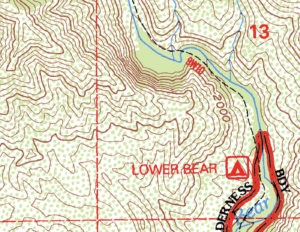 02 The campground to the west of Bear Creek is on a relatively gentle east-facing slope. If you were to leave Lower Bear Campground and head west, you would climb up to the crest of a 2,200-foot hill (with an elevation change of only 280 feet). Because the contour lines are so far apart (in the center of this picture), they indicate somewhat level ground.
02 The campground to the west of Bear Creek is on a relatively gentle east-facing slope. If you were to leave Lower Bear Campground and head west, you would climb up to the crest of a 2,200-foot hill (with an elevation change of only 280 feet). Because the contour lines are so far apart (in the center of this picture), they indicate somewhat level ground.
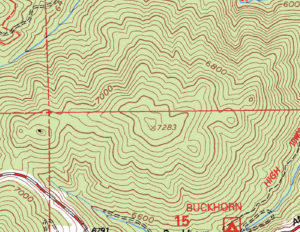 03 One of the highest points on the Waterman Mountain quadrangle map is this 7,283-foot peak, easily seen by the contour lines circling around each other. All the way around, the mountain has a steady rise, and has the appearance of a rounded pyramid in shape with several sub-peaks on the southeast face. The red-and-white-striped line in the lower left is Angeles Crest Highway.
03 One of the highest points on the Waterman Mountain quadrangle map is this 7,283-foot peak, easily seen by the contour lines circling around each other. All the way around, the mountain has a steady rise, and has the appearance of a rounded pyramid in shape with several sub-peaks on the southeast face. The red-and-white-striped line in the lower left is Angeles Crest Highway.
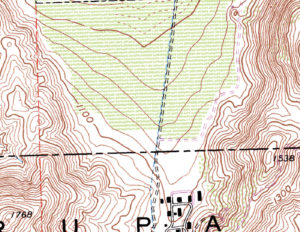 04 The widely spaced contour lines in this section of the Fontana quadrangle show a typical alluvial plane gently descending north from steadily narrowing canyon. At the bottom, the map lists the interval at 20 feet. At the base of that canyon are several buildings in black. To the east, the walls of the canyon rise sharply, from 1,100 feet at the bottom of the natural amphitheater to 1,538 at its peak. The green shading shows that a road (dotted line) runs through this flat canyon, following a natural stream (blue line) through the middle of it.
04 The widely spaced contour lines in this section of the Fontana quadrangle show a typical alluvial plane gently descending north from steadily narrowing canyon. At the bottom, the map lists the interval at 20 feet. At the base of that canyon are several buildings in black. To the east, the walls of the canyon rise sharply, from 1,100 feet at the bottom of the natural amphitheater to 1,538 at its peak. The green shading shows that a road (dotted line) runs through this flat canyon, following a natural stream (blue line) through the middle of it.
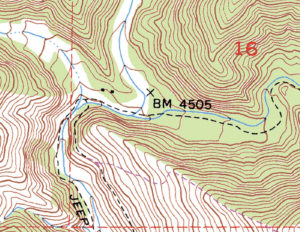 05 This shows the convergence of three canyons in the Mt. San Antonio quadrangle: Vincent Gulch from the north, Mine Gulch from the west and Prairie Fork in the east. A Jeep trail (dotted black line) runs through the canyon. The dotted blue line through Mine Gulch indicates a narrow wash (most likely dry), while the v-shapes of the contour lines in the various gulches point towards upstream. The “BM 4505” signifies a four-inch copper marker, placed in concrete by the original surveyor of the area.
05 This shows the convergence of three canyons in the Mt. San Antonio quadrangle: Vincent Gulch from the north, Mine Gulch from the west and Prairie Fork in the east. A Jeep trail (dotted black line) runs through the canyon. The dotted blue line through Mine Gulch indicates a narrow wash (most likely dry), while the v-shapes of the contour lines in the various gulches point towards upstream. The “BM 4505” signifies a four-inch copper marker, placed in concrete by the original surveyor of the area.
Editor’s Note: A version of this article first appeared in the Winter 2016 print issue of Tread Magazine.

